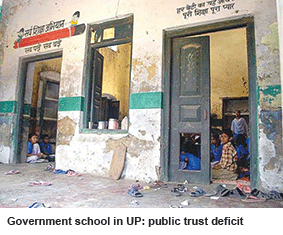 AN ELECTRONIC DATABASE engineered to track the number of children in government primary schools with the objective of controlling wastage of social benefits — free mid-day meals, textbooks, uniforms etc — has yielded unexpected data. Of the total 159,625 state government primary-secondary schools, 6,898 have less than 25 students on their muster rolls while 22,959 schools have between 26-50 students, all told.
AN ELECTRONIC DATABASE engineered to track the number of children in government primary schools with the objective of controlling wastage of social benefits — free mid-day meals, textbooks, uniforms etc — has yielded unexpected data. Of the total 159,625 state government primary-secondary schools, 6,898 have less than 25 students on their muster rolls while 22,959 schools have between 26-50 students, all told.
This picture of primary education in India’s most populous (212 million) state could prove to be worse as data for only 139,411 (87.3 percent) government schools has thus far been uploaded. Only 60,875 (43 percent) government schools report more than 100 children on their rolls. The significance of this data is that it is possible that in the 6,898 government primaries with less than 25 students, the number of teachers and employees drawing generous Seventh Pay Commission-awarded pay scales may well exceed the number of students — a huge wastage of taxpayers’ money.
This public trust deficit in the efficacy of the government school system within even bottom-of-pyramid households who prefer to enroll their children in private ‘budget’ schools has set alarm bells ringing in Lucknow. On March 19, the education ministry announced an initiative to grade primary schools to determine which schools need quality upgradation. Under the plan, a two-member team, comprising a member from the block education resource centre and principal of the District Institution of Education and Training, will visit every primary school and grade it on 100 points divided over a number of parameters such as exams performance (55 points), physical infrastructure and community participation (5 points each), attendance (15 points) and standard of teaching (20 points).
The small minority of monitors of UP’s government school system defined by ramshackle buildings and infrastructure, chronic teacher absenteeism and poor learning outcomes, attribute loss of public confidence to a general lack of seriousness about primary education in successive state governments and particularly the incumbent Samajwadi Party government elected in 2012. For instance, in the final exams for class II-VIII students held between March 6-21, the education ministry had announced that students would also be tested in physical education, moral science, art and environment studies to bring them on a par with private school children. However, in many districts including the state capital Lucknow, question papers didn’t reach schools on time. This, despite sufficient financial provision (Rs.18.2 crore) having been made for conducting primary school exams.
“We need to re-look where new government schools are sited. Where reasonable quality private schools exist, the focus of the state government should be on improving the quality of existing government schools rather than starting new ones. Likewise, a greater proportion of the state government’s education budget needs to be spent on teacher training and development so they can improve classroom learning,” says Sarvendra Vikram Singh, director of UP’s State Council for Educational Research & Training.
However Juhie Singh, chairperson of the State Commission for Protection of Child Rights, who has been on a surprise school visits spree, believes that the Central and state government’s allocations for the Sarva Shiksha Abhiyan (elementary education for all) to which the Centre contributes 60 percent with the state government obliged to contribute 40 percent for which a mere Rs.15,397 crore has been provided in the state budget 2016-17, needs to be hugely increased. “The infrastructure of most government schools is uninviting to parents, children and teachers. Most school buildings are crumbling, and lack drinking water and toilets. Teachers are reluctant to attend school to teach and the community isn’t interested in being involved with them. All of them require comprehensive repair and rehabilitation,” says Singh.
Quite clearly, India’s most populous state which grudgingly hosts 25 million children in the 6-14 (primary school) years age group, needs to budget more than Rs.15,397 crore per year — Rs.5,966 per capita — in public primary education. Until it does, the flight from government schools into private schools and illiteracy will continue.
Puja Awasthi (Lucknow)



























